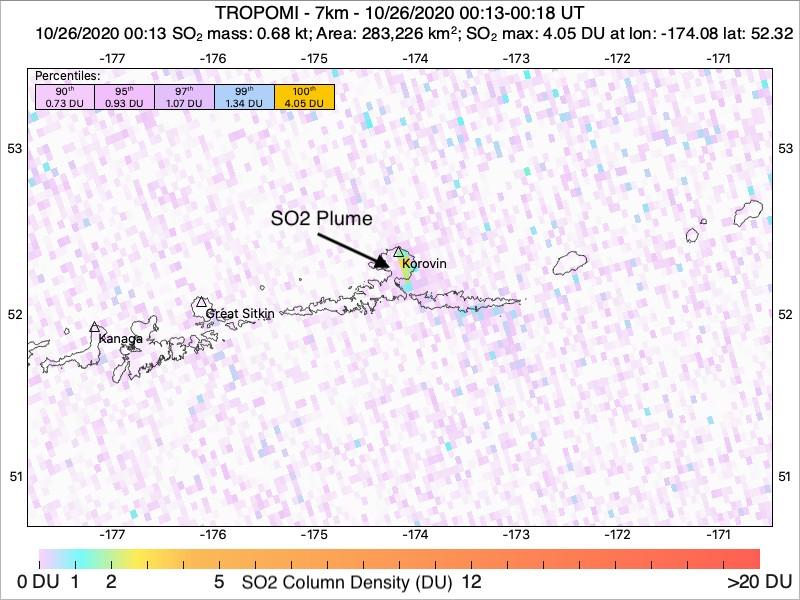
Sulfur dioxide (SO2) is a common volcanic gas that is released from magma within Earth’s upper crust. While SO2 is commonly released from Alaska’s active volcanoes, including Korovin, a recent increase in satellite detections of SO2 emissions from Korovin may be a sign of volcanic unrest. In sufficient quantity, SO2 can be readily measured from space due to its low quantity in background air. This image shows SO2 emissions from Korovin that were detected by the TROPOMI satellite sensor on October 26, 2020. In this image, the warmer colors represent larger quantities of SO2 measured within a column of atmosphere. These SO2 column densities are reported in Dobson Units (DU) where 1 DU = 2.85 x 10^-2 g of SO2/m^2. AVO will continue to monitor satellite detections of SO2 from Korovin, in combination with other volcano monitoring techniques, to evaluate ongoing activity at Korovin volcano.
Volcano(es): Korovin
Photographer: Lopez, Taryn
URL: avo.alaska.edu/image/view/162301
Credit: Image courtesy of the AVO/UAF-GI.
Use Restriction: Please cite the photographer and the Alaska Volcano Observatory / University of Alaska Fairbanks, Geophysical Institute when using this image.
Full Resolution.
Korovin unrest 2020/10
From Orr and others, 2024: "The first indication of unrest at Atka volcanic complex in 2020 was a small increase in seismic activity. This activity started in early June and culminated with episodic tremor on June 11-12. The amplitude of the tremor pulses, which each lasted 10-40 minutes, increased slowly and peaked on June 12 at ~13:50 UTC (~04:50 HADT). The tremor then subsided to background levels for the next several months.
"Beginning on October 15, the TROPOMI satellite instrument made occasional SO2 detections at Atka volcanic complex. These SO2 detections were the first at the complex in 2020 and indicated elevated volcanic degassing. An additional two satellite SO2 detections were made during the next two weeks, which also coincided with an increase in the number of earthquakes located in the area. In response to this heightened level of activity, AVO elevated the Aviation Color Code and Volcano Alert Level to YELLOW and ADVISORY on October 28. No additional satellite SO2 detections were made in the following weeks, and seismicity declined in late November, indicating a return to background activity. AVO subsequently lowered the Aviation Color Code and Volcano Alert Level back to GREEN and NORMAL on December 3."